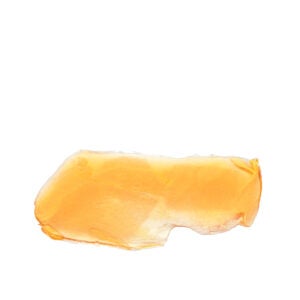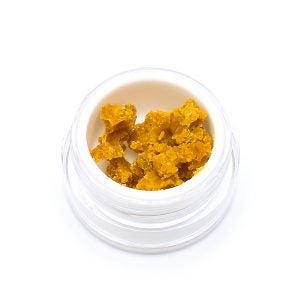Table of Contents
- What is Shatter?
- What is Wax?
- What are Cannabis Concentrates?
- The Benefits of Concentrates and Extracts
- Shatter vs Wax: The Difference
- The Best Shatter Brands to Buy in Canada
- Choosing Between Shatter and Wax Cannabis Concentrates
Both shatter and wax are cannabis concentrates. Though they can appear similar to the untrained eye, there are actually many differences between wax and shatter.
If you’re opting for concentrates, you’re already on the right path to quality, potency, and a great experience. So, to help you make your choice between wax and shatter, let’s take a look at what differentiates these two popular cannabis concentrates.
What is Shatter?
Shatter is one of many popular cannabis concentrate products available via online dispensaries today. It’s gained popularity thanks to its versatility and potency. As a cannabis extract, shatter gives consumers a slightly heavier potency than smoking or consuming cannabis directly from the plant.
Distinguished by its unique appearance, shatter is sold and purchased as a solid. Though it has a brittle consistency that gives it its name – you may find that it looks and feels similar to broken glass.
What is Wax?
Wax is another cannabis concentrate that many consumers know and love. Sometimes called weed wax, this cannabis extract is made from a highly concentrated substance derived from cannabis plants.
Typically, wax can be distinguished by its honey colour. Unlike the brittle texture of shatter, wax has a softer consistency. Wax, although its own concentrate product, is sometimes referred to as shatter. It can also be called earwax, honeycomb, nectar, or amber.
What are Cannabis Concentrates?
You likely know what cannabis looks like in its farmed and true form – like leafy green plants and then like dried nugs. When cannabis is harvested, the flowers are sold we weed or bud. Recently, however, cannabis growers and manufacturers have been producing a variety of products created using cannabis extracts.
Concentrates, made from extracted cannabis materials, have become a popular option among consumers.
Cannabis concentrates are made by removing the plant material (like the leaves and stems), leaving a concentrated extraction of trichomes (i.e. the terpenes, cannabinoids) that give the plant its effects and benefits. Essentially, you’re getting all the good stuff in a more concentrated format.
Depending on the type of product being produced, cannabis extracts are created using solvent-based or solvent-less extraction methods. Besides shatter and wax, a few other common cannabis concentrates include resin, oils, rosin, and budder.
The Benefits of Concentrates and Extracts
There are plenty of benefits to choosing cannabis concentrates. High-quality concentrates like hash, wax and shatter have many benefits that help the user. Sure, we still love old-fashioned buds (weed flower), but with extracts, you can’t go wrong.
Concentrates have the advantage of containing a higher concentration of cannabinoids, meaning that the ratio of THC and CBD can lead to a stronger potency.
To give you an idea of why we love them, here are some of the benefits of cannabis concentrates:
- Made from high-quality cannabis plants
- Higher concentration of terpenes for stronger potency
- More cost-effective
- Kicks in faster than smoking bud
- Various choices for consumption methods
Another big plus for many consumers is that concentrates don’t necessarily need to be smoked, which can be a welcome relief for your lungs from time to time.
Shatter vs Wax: The Difference
Now that we’ve covered what you need to know about cannabis concentrates let’s get into the big debate. Which is better: shatter or wax?
From methods of production to appearance to effects to consumption, here are the things that differentiate shatter and wax.
Appearance
Though some people use the terms interchangeably, when you see shatter and wax side by side, it’s hard to think they are the same thing. These two concentrates have different appearances that can help you distinguish one from the other.
As for colour and consistency, shatter has a yellow tinge but can range from dark yellow to amber and darker olive. It can also be somewhat transparent or translucent. It’s a hard, brittle, glass-like consistency. Consumers often compare the texture and consistency of shatter to peanut brittle that can be melted when consumed.
Wax is softer and more malleable and can take on the consistency of dense jello or butter. It’s more of a solid than oil but not quite as hard as shatter. Like its cousin, shatter, wax also has a yellow or amber-hued tint but is more often opaque rather than transparent.
Method of Production
Though shatter and wax are both made from cannabis plants being extracted and produced in a concentrated substance, their method of extraction and production is not exactly the same.
For wax, the extraction method uses less heat. When making wax, the concentrate is mixed more aggressively than it is in the production of shatter. The molecules are held together is a looser format, making this concentrate relatively easier to produce.
Shatter, on the other, is made using a more precise method. The plant material is immersed in solvents such as butane, isopropyl alcohol, or CO2. The solvents are used to condense the plant material. Several cycles are used to delicately purge the plant material of solvents that were used in the extraction process.
What’s left is the concentrated product in oil form. This oil is then condensed yet again to form a brittle substance that looks like hardened peanut brittle.
In the production of shatter, the extraction method uses more heat. The molecules are more tightly aligned, causing a firmer filtration and concentration.
If that scientific explanation was confusing, it comes down to shatter being a more “pure” product than wax thanks to the method of extraction and production.
Effects
As with other cannabis concentrates, both wax and shatter have the benefit of higher potency thanks to the concentration of terpenes and cannabinoids. Another bonus is that there is also a concentration of flavonoids, meaning that the overall experienced is heightened even more, thanks to the full flavour profile and aromas.
The exact effects of consuming concentrates depend on the strain used in extraction. It’s possible to dose more accurately with certain concentrates, so you’ll be able to get the full experience of the strain.
Consumption
Shatter may come out as the winner in this category. Thanks to its varying consistency, shatter can be consumed in a variety of ways. With shatter, you have choices for consuming, and you can use accessories you probably already own.
The most popular way to consume shatter is with a dab rig. But it can also be smoked in a spliff or joint. Shatter can, additionally, be added to a bong and even vaped using a vape pen. Both shatter and wax can be used when dabbing.
Shatter can, however, be slightly more difficult to use. Due to its glassy texture, shatter isn’t always easy to manage. Wax, on the other hand, is more manageable – especially when adding it to a joint.
Lastly, shatter also has a longer shelf life than wax – its soft state causes it to break down faster, meaning you have to use it sooner.
The Best Shatter Brands to Buy in Canada
Tried, tested, and enjoyed. Here are the best brands that sell shatter concentrates in Canada. All made with high-quality cannabis, these cannabis extracts from Canadian cannabis brands aren’t playing games.
Choosing Between Shatter and Wax Cannabis Concentrates
When it comes to choosing the best type of cannabis concentrate, whether it’s shatter, wax, budder, or something else entirely, it largely comes down to personal preference.
Do you value the preservation of terpenes? Do you want a full flavour profile? Figure out your likes and dislikes, and go from there. Don’t be afraid to try different products as you discover what’s best for you.
The difference between shatter and wax, for some, might come down to the product’s shelf life. Due to its softer consistency, wax should be used sooner, while the hard texture of shatter allows it to stay good longer.
The options for consumption may also play a part in your choice. If you’re looking for a range of different methods of consumption, wax has a variety of options. That said, the brittle texture can make it difficult to use in a joint.
The obvious answer to this debate is, of course, to try both!



